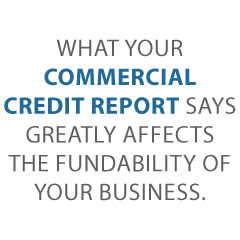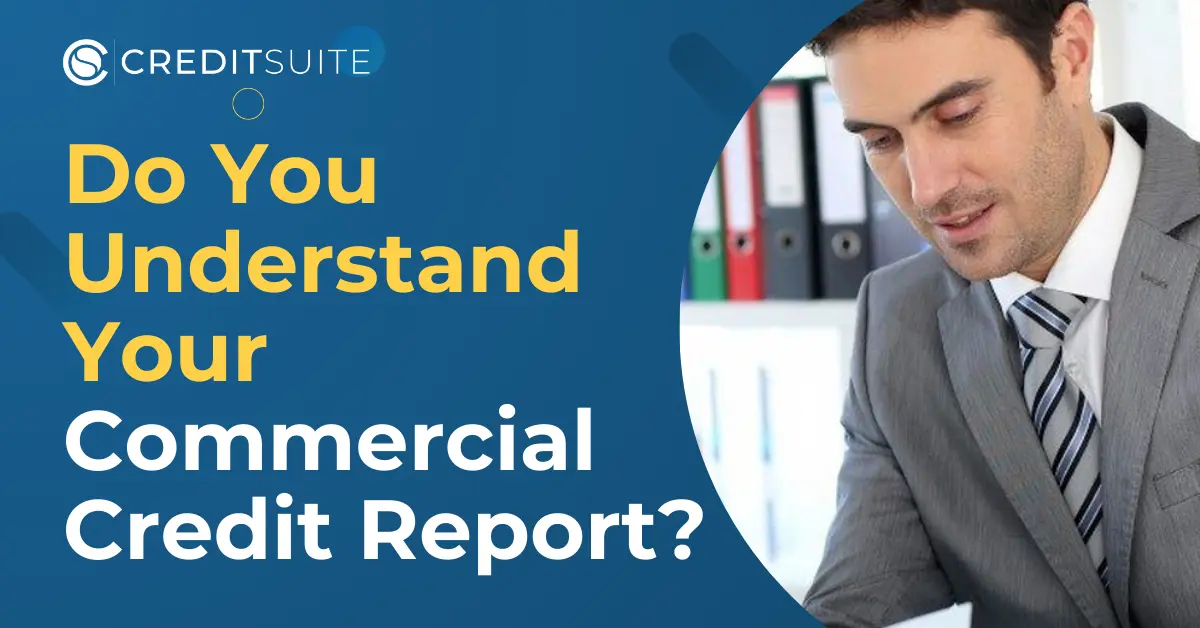Lenders often look at your commercial credit report in addition too, or in lieu of, your personal credit score. As you know, they use the information on the report to help them decide if your business is a good credit risk, or a bad one.
Your Commercial Credit Report Can Affect the Fundability of Your Business
So, why is it important to understand your commercial credit report? The answer is, because what your commercial credit report says greatly affects the fundability of your business. Of course, there are many factors that affect Fundability, and it is important to understand each of them. However, there are many pieces to the fundability puzzle and it is best to understand each one individually.
Commercial Credit Report: Dun & Bradstreet
Dun & Bradstreet offers six different reports. Truly, the one utilized most often by lenders is the PAYDEX. Honestly, this is probably because it is the one most like the consumer FICO score. You see, it measures how quickly a company pays its debt on a scale of 1 to 100. For reference, lenders like to see a score of 70 or higher.
To put it in perspective, a score of 100 reveals the firm makes payments ahead of time. A rating of 1 shows they pay 120 days late, or more.
Together with PAYDEX, they offer the following scores and reports.
Delinquency Predictor Score
As you might imagine, this rating determines the chance the company will not pay, will be late paying, or will come file for bankruptcy. For scoring, the range is 1 to 5, with 2 being a good score.
Financial Stress Score
Not surprisingly, this is a measurement of the pressure on a firm’s balance sheet. It shows the possibility of a closure within a year. The range is 1 to 5, and a 2 is good.
Supplier Evaluation Risk Rating
This is a ranking that predicts the odds of a firm surviving one year. Similarly, it ranges from 1 to 9, with a 5 being a good score.
Credit Limit Recommendation
As the name implies, this is a recommendation for the amount of debt a company can handle. Financial institutions usually use it to establish how much credit to extend.
D&B Credit Rating
This is an estimation of overall business risk on a scale of 4 to 1, where a 2 is considered good. The smaller the number the better. The rating is given as a combination of numbers and letters, which together show a company’s net worth.
Consequently, if there isn’t enough data on a business to assign a regular rating, an alternative score is assigned. This is called a credit approval score. It is based on the number of employees. They will use any data they have available to calculate this alternative rating. That means, a company can control this to a point by ensuring D&B has all of the information they need.
Commercial Credit Score
Along with the PAYDEX, Dun & Bradstreet releases a commercial credit report in three components. Each part shows how likely the business is to default on expenses or become seriously late on payments.
Commercial Credit Score
On a range of 101 to 670, the commercial credit score anticipates the likelihood of a firm making late payments. A rating of 101 indicates it is very likely that the company will be late with payments. Likewise, a score of around 500 is good.
Commercial Credit Percentile
For this measurement, the scale runs from 0 to 100. It shows the chance of delinquency too. However, it determines this probability versus other companies in the Dun & Bradstreet system. A rating of 1 is the highest possible probability in relation to other companies. The majority of loan providers consider a rating of 80 or higher to be an advantage.
Commercial Credit Class
In contrast to the other reports, this is an approach of dividing businesses into classes based on the chance of delinquency. Firms in class 1 are the least likely to be overdue. Likewise, if you are in class 2, that’s still good.
What Goes into the D&B Commercial Credit Report Ratings Calculation?
The exact formula used by Dun & Bradstreet to calculate their ratings is proprietary. What we do know is what information they look for and where they get it. The initial source of this information is the business itself.
A business must submit a financial statement to D&B before getting a full rating. Without that, a business gets a limited rating based on the number of employees. For example, the rating would be 1R if the business has 10 employees or more. But it’s 2R if they have fewer than 2 employees.
With no financial statement, a composite credit appraisal can still be issued. However, a business is only eligible for a rating up to a 2 in this case. They are ineligible for a 1 rating without a financial statement.
Businesses can also submit trade references to Dun & Bradstreet themselves. The catch is, it costs money to do so. Furthermore, there is no guarantee it will result in a score increase. Anyway, if you are properly building business credit it will happen for free.
Besides getting data from the business, Dun & Bradstreet also accesses public records. They look for liens and bankruptcies, and anything to show creditworthiness, or a lack thereof. They also partner with the Small Business Finance Exchange to access data from their records.
Commercial Credit Report: Experian Business Credit Scores
Experian gathers data from a lot of the same sources as Dun & Bradstreet. As a result, their reports are similar. There are a few key differences in sources, calculation, and also presentation however.
Intelliscore Plus
Experian uses the Intelliscore Plus credit score, which shows a statistics-based credit risk. The result is, it is a highly predictive score that can help users make well-informed credit decisions.
The Intelliscore scores range from 1 to 100, with a higher score indicating a lower risk class.
Score Range Risk Class
| Low Risk | 76-100 |
| Low-Medium Risk | 51-75 |
| Medium Risk | 26-50 |
| High-Medium Risk | 11-25 |
| High Risk | 1-10 |
Exactly How Does Experian Compute the Intelliscore Rating?
One of the things Intelliscore is most known for is the list of specific key factors they use that can indicate how likely a business is to pay its debt. In fact, over 800 variables go into the Intelliscore Plus calculation. Many of them are from the general information all credit agencies look at. However, some are unique to Experian. Here’s a breakdown.
Payment History
As you might imagine, this is your current payment status. That means, it shows how many times accounts have become delinquent. It also shows how many accounts are currently delinquent, as well as the overall trade balance.
Frequency
Frequency shows how many times your accounts have gone to collections. In addition, it notes the number of liens and judgments you have. Also, it shows any bankruptcies related to your business or personal accounts.
It also incorporates information about your payment patterns. Were you regularly slow or late with payments? Did you decrease the number of late payments over time? That affects your score.
Monetary
This specific factor focuses on how you use credit. For example, how much of your available credit are you utilizing right now? Do you have a high ratio of late balances when compared with your credit limits?
Of course, if you are a new business owner, a lot of this information will not exist yet. Intelliscore Plus handles this by using a blended model to identify your score. This means your personal credit score becomes part of determining your business’s credit score.
Experian’s Blended Score
Surprising to some, the blended score is a one-page report that provides a summary of the business and its owner. A combined business-owner credit scoring model works better than a business or consumer only model. In fact, blended scores have been found to outperform consumer or business scores alone by 10 – 20%.
Experian Financial Stability Risk Score (FSR)
FSR predicts the potential of a business going bankrupt or not paying its debts. Consequently, this score identifies the highest risk businesses by using payment and public records. They look at a number of factors, some of which include:
- high use of credit lines
- severely late payments
- tax liens
- judgments
- collection accounts
- risk industries
- length of time in business
Commercial Credit Report: The Equifax Service Credit Rating
Similarly, Equifax shows three different points on its commercial credit report. These include:
Equifax Payment Index
Similar to PAYDEX, Equifax’s payment index is a measurement on a scale of 100. It shows how many of your small business’s payments were made on time. Like the others, it uses data from both creditors and vendors. However, it’s not meant to anticipate future behavior. That is what the other two scores are for.
Equifax Credit Risk Score
This score shows the likelihood of your company becoming severely delinquent on payments. Scores range from 101 to 992 and include an evaluation of:
- Available credit limit on revolving credit accounts, including credit cards
- Company size
- Proof of any non-financial transactions (like merchant invoices) which are late or were charged off for two or more billing cycles
- Length of time since the opening of the earliest financial account
Equifax Business Failure Score
Equifax’s business failure score takes a look at the risk of your business shutting down. Similar to others, it runs from 1,000 to 1,600 and bases its scoring on these factors:
- Total balance to total current credit limit in the past three months
- The amount of time since the opening of the oldest financial account
- Your small business’s worst payment status on all trades in the last 24 months
- Proof of any non-financial transactions, like merchant invoices, which are late or are on a charge off for two or more billing cycles
For the credit risk and the business failure scores, a rating of 0 means bankruptcy.
Equifax Scores
A positive Equifax score for your business is as follows:
- Payment Index 0 to 10
- Credit Risk score 892 to 992
- Business Failure score 1400 to 1600
Are These the Only Agencies Where You Can Get a Commercial Credit Report?
Actually, there are multiple other agencies that will issue a commercial credit report. It’s just that these three are the most commonly used. Still, there has been an increase in the use of another option recently. It’s the FICO SBSS.
Commercial Credit Report: What is the FICO SBSS?
The FICO SBSS is the business variation of your personal FICO credit report. Unlike your personal FICO, the SBSS reports on a scale of 0 to 300. The higher the score the better. However, the majority of loan providers demand a rating of least 160.
How Do They Come Up with The FICO SBSS Score?
Surprisingly, it is significantly different from other business credit scoring designs. The SBSS utilizes your corporate credit score and personal credit rating. It also makes use of monetary details like business assets and income. As you can see, the goal is to give an overall financial picture rolled into one rating.
Unfortunately, business owners cannot access their FICO SBSS by themselves. There is a proprietary formula for score computations. Furthermore, they do not make that data public. As a result, you go into lending institutions blind as to what your FICO SBSS credit rating might be.
Complicating things even more, lenders can choose how certain factors are weighted in the calculation of your score. This means your FICO SBSS could actually be different from one lender to the next. For example, one lender could put more weight on your business payment history, while another could lean more on your personal credit score.
How Does Your Commercial Credit Report Affect Overall Fundability?
As I said before, overall business fundability is an intricate web woven out of your business information, business credit, organization, personal credit, public records and more. Your business credit, though only one part, is a large part of the Fundability™ puzzle.
This means, you need to know what your commercial credit report says, why it says it, how it is affecting the Fundability™ of your business, and how to make changes when necessary.


